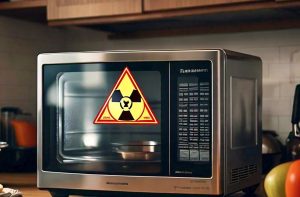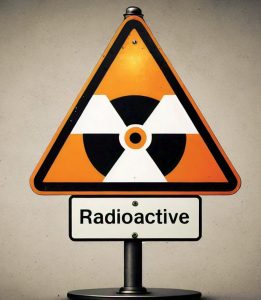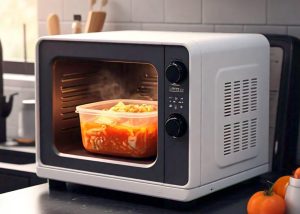Microwave radiation refers to the waves of electromagnetic energy that microwaves use to heat food.
The question at hand is whether this microwave radiation can potentially cause harm or not.
This article will delve into an exploration of microwave radiation, its effects and safety considerations. We aim to provide a comprehensive understanding by discussing if and how it could possibly be harmful, backed up with scientific facts about this type of electromagnetic energy. If proven hazardous, alternatives to microwaving or safety tips for using a microwave will also be shared for readers who want safer cooking methods. We’ll wrap up our discussion with frequently asked questions and final thoughts on the subject.

Jump To:
Can Microwave Radiation Hurt You?
Yes, microwave radiation can potentially hurt you if exposed excessively and directly. Although microwaves are generally safe for everyday use, excessive exposure may lead to thermal burns and detrimental biological effects on tissues and cells. However, the risk is minimized by proper use and maintenance of the appliance while ensuring it’s in good condition without leakages.
Check out if a microwave can leak radiation.
Facts About Microwave Radiation
Here we will discuss the important things to note about microwave radiation.
- Type: Microwave radiation refers to the waves of electromagnetic energy commonly used in telecommunication, radar detection, and in kitchen appliances for heating food.
- Safety: It is generally safe but can cause harm if a person is exposed directly to high levels of microwaves. Microwaves heat tissues up like food which can result in burns or cataracts.
- Emission: All microwave ovens leak some amount of radiation, but these levels are below safety standards set by regulatory bodies and pose no known health risks when used correctly.
- Microwave effect on Food: They primarily heat water, fats, and sugars they encounter, leaving most vitamins unharmed. When used properly it may retain more nutrients than other cooking methods that expose foods to high temperatures for a longer period.
- Penetration Depth: Microwave ovens usually do not cook as deeply as conventional methods. Generally, only 1 inch (2.54 cm) of food per side gets cooked by microwaves directly – deeper parts are heated via conduction from hotter outer layers.
In conclusion, microwave radiation has its uses and precautions associated with it.
Check out how hot a microwave can get.
Now, let’s discuss how this affects the process of microwaving different types of foods.
What are the Alternatives to Microwaving?
The primary alternatives to microwaving include traditional methods such as oven baking, stovetop cooking, and steaming. These methods have been employed for centuries and continue to serve us well. They all provide a unique way of preparing food that brings out different flavors and textures not always achievable with microwave radiation.
Check out if microwave can kill bacteria.
Tips to Microwave Safely
Here are a few useful tips to microwave safely:
- Microwave at lower power levels where necessary; longer heating times at lower power settings can cook more evenly.
- Avoid using containers that aren’t marked ‘microwave-safe‘. Certain plastics may melt or release harmful chemicals when heated in the microwave.
- Piercing foods with a thick skin like potatoes or whole vegetables prevents them from exploding due to steam build-up inside.
- Stirring food halfway through its cooking time promotes uniform heat distribution leading towards equal doneness of the entire dish.
- Always let your food stand for a few minutes after microwaving it. This allows residual heat to complete the cooking process without overdoing it.
In this section, we discussed alternative preparation techniques as opposed to using microwave radiation, along with some valuable safety tips for those who choose to use a microwave.
In the next section, we will address some frequently asked questions about microwaves.

Frequently Asked Questions (FAQs)
Let’s now delve into the most commonly asked queries related to microwave radiation and heating.
Can microwave radiation hurt you?
Microwave radiation, like that from a microwave oven, can indeed harm you if not appropriately used. However, microwaves are designed with safety measures to prevent such exposure. So long as the appliance is functioning correctly and not physically damaged or modified in any way that defeats these safety features, exposure to harmful levels of microwave radiation should be negligible.
Can microwaving food diminish its nutritional value?
In reality, any cooking method can reduce the nutritional content of food due to heat’s impact on certain nutrients. However, microwaving often requires shorter cooking times than traditional methods, thus minimizing nutrient loss. Therefore, it isn’t accurate to claim that microwaving food substantially decreases its nutritional value compared to other modes of heating.
Could overheating water in the microwave cause it to explode?
Absolutely yes! Overheating water in a microwave can cause it to explode or “superheat.” This happens when water is heated beyond its boiling point without forming visible bubbles. Upon disturbance like adding a tea bag or stirring spoon could trigger an abrupt release of built-up energy causing an explosion-like effect.
Is standing near a microwave harmful due to radiation leakage?
No significant evidence suggests standing near a well-maintained and properly operating microwave poses health risks due to radiation leakage. Most modern microwaves have protective shielding which reduces possible leakage well below permissible limits established by health authorities worldwide.
We hope these answers have clarified some common misconceptions about using microwaves for heating purposes.
Final Word
Microwave radiation, while potentially harmful in large doses or under specific conditions, is generally safe for everyday use in heating and cooking food at home. Modern microwaves are designed with numerous safety features to protect users from exposure to high levels of microwave radiation. As long as these appliances are properly maintained and used correctly, there should be minimal risk of harm.



